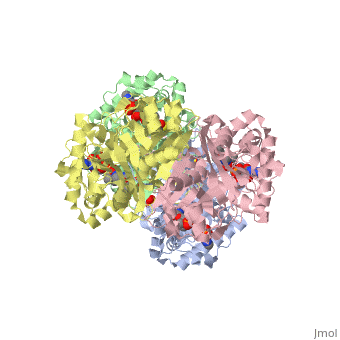1dm3
From Proteopedia
ACETYLATED BIOSYNTHETIC THIOLASE FROM ZOOGLOEA RAMIGERA IN COMPLEX WITH ACETYL-COA
Structural highlights
FunctionEvolutionary ConservationCheck, as determined by ConSurfDB. You may read the explanation of the method and the full data available from ConSurf. Publication Abstract from PubMedBiosynthetic thiolases catalyze the biological Claisen condensation of two acetyl-CoA molecules to form acetoacetyl-CoA. This is one of the fundamental categories of carbon skeletal assembly patterns in biological systems and is the first step in many biosynthetic pathways including those which generate cholesterol, steroid hormones and ketone body energy storage molecules. High resolution crystal structures of the tetrameric biosynthetic thiolase from Zoogloea ramigera were determined (i) in the absence of active site ligands, (ii) in the presence of CoA, and (iii) from protein crystals which were flash frozen after a short soak with acetyl-CoA, the enzyme's substrate in the biosynthetic reaction. In the latter structure, a reaction intermediate was trapped: the enzyme was found to be acetylated at Cys89 and a molecule of acetyl-CoA was bound in the active site pocket. A comparison of the three new structures and the two previously published thiolase structures reveals that small adjustments in the conformation of the acetylated Cys89 side-chain allow CoA and acetyl-CoA to adopt identical modes of binding. The proximity of the acetyl moiety of acetyl-CoA to the sulfur atom of Cys378 supports the hypothesis that Cys378 is important for proton exchange in both steps of the reaction. The thioester oxygen atom of the acetylated enzyme points into an oxyanion hole formed by the nitrogen atoms of Cys89 and Gly380, thus facilitating the condensation reaction. The interaction between the thioester oxygen atom of acetyl-CoA and His348 assists the condensation step of catalysis by stabilizing a negative charge on the thioester oxygen atom. Our structure of acetyl-CoA bound to thiolase also highlights the importance in catalysis of a hydrogen bonding network between Cys89 and Cys378, which includes the thioester oxygen atom of acetyl-CoA, and extends from the catalytic site through the enzyme to the opposite molecular surface. This hydrogen bonding network is different in yeast degradative thiolase, indicating that the catalytic properties of each enzyme may be modulated by differences in their hydrogen bonding networks. Crystallographic analysis of the reaction pathway of Zoogloea ramigera biosynthetic thiolase.,Modis Y, Wierenga RK J Mol Biol. 2000 Apr 14;297(5):1171-82. PMID:10764581[1] From MEDLINE®/PubMed®, a database of the U.S. National Library of Medicine. See AlsoReferences
| ||||||||||||||||||||


